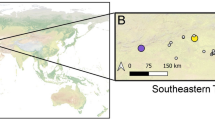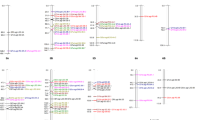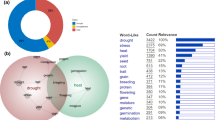Abstract
Arguably the most important adaptive criterion in annual crops is appropriate phenology that minimizes exposure to climatic stresses and maximizes productivity in target environments. To date this has been achieved empirically by selecting among diverse genotypes in target locations. This approach is likely to become inadequate with pending climate change because selection is imposed on the outcome (flowering time) rather than the underlying mechanism (i.e. responses to daylength, ambient or vernalizing temperatures). In contrast to the cereals, in legumes the interaction between phenological mechanisms and environmental selection pressure is largely unknown. This paper addresses this shortcoming through photothermal modelling of chickpea germplasm from the world’s key production areas using a meta-analysis of multi-environment trials located from 49° N to 35° S. Germplasm origin had significant effects on temperature and daylength responsiveness, the former strongly correlated to vegetative phase temperatures at the collection or development site (r = 0.8). Accordingly, temperature responses increase from winter- to spring-sown Mediterranean and Australian material, and then to north, central & southern India. Germplasm origin also affects the relationship between photoperiod and temperature response. In Eastern Mediterranean material a strong negative relationship (r = −0.77) enables temperature insensitive genotypes to compensate through a strong photoperiod response. Clearly, chickpea evolution has selected for different phenological mechanisms across the habitat range. Given that under the anticipated global warming temperature sensitive cultivars will flower relatively earlier than those responding largely to photoperiod, it is important to exploit this diversity in developing better-adapted genotypes for future cropping environments.




Similar content being viewed by others
References
Ben-David R, Abbo S, Berger JD (2010) Stress gradients select for ecotype formation in Cicer judaicum Boiss., a wild relative of domesticated chickpea. Genet Resour Crop Evol 57:193–202
Berger JD (2007) Ecogeographic and evolutionary approaches to improving adaptation of autumn-sown chickpea (Cicer arietinum L.) to terminal drought: the search for reproductive chilling tolerance. Field Crops Res 104:112–122
Berger JD, Turner NC (2007) The ecology of chickpea: evolution, distribution, stresses and adaptation from an agro-climatic perspective. In: Yadav SS, Redden R, Chen W, Sharma B (eds) Chickpea breeding and management. CABI, Wallingford, pp 47–71
Berger JD, Turner NC, Siddique KHM, Knights EJ, Brinsmead RB, Mock I, Edmondson C, Khan TN (2004) Genotype by environment studies across Australia reveal the importance of phenology for chickpea (Cicer arietinum L.) improvement. Aust J Agric Res 55:1071–1084
Berger JD, Buck R, Henzell JM, Turner NC (2005) Evolution in the genus Cicer—vernalisation response and low temperature pod set in chickpea (C. arietinum L.) and its annual wild relatives. Aust J Agric Res 56:1191–1200
Berger JD, Ali M et al (2006) Genotype by environment studies demonstrate the critical role of phenology in adaptation of chickpea (Cicer arietinum L.) to high and low yielding environments of India. Field Crops Res 98:230–244
Clarke HJ, Siddique KHM (2004) Response of chickpea genotypes to low temperature stress during reproductive development. Field Crops Res 90:323–334
Dong J, Liu J, Tao F, Xu X, Wang J (2009) Spatio-temporal changes in annual accumulated temperature in China and the effects on cropping systems, 1980s to 2000. Clim Res 40:37–48
Ellis RH, Lawn RJ et al (1994) Towards the reliable prediction of time to flowering in six annual crops. V. Chickpea (Cicer arietinum). Exp Agric 30:271–282
Erskine W, Ellis RH, Summerfield RJ, Roberts EH, Hussain A (1990) Characterization of responses to temperature and photoperiod for time to flowering in a world lentil collection. Theor Appl Genet 80:193–199
Gbetibouo G, Hassan R (2005) Measuring the economic impact of climate change on major South African field crops: a Ricardian approach. Global Planet Change 47:143–152
Grime JP (1979) Plant strategies and vegetation processes. Wiley, Chichester
Hijmans RJ, Guarino L, Cruz M, Rojas E (2001) Computer tools for spatial analysis of plant genetic resources data: 1. DIVA-GIS. Plant Genet Resour Newslett 127:15–19
Hijmans RJ, Cameron SE, Parra JL, Jones PG, Jarvis A (2005) Very high resolution interpolated climate surfaces for global land areas. Int J Climatol 25:1965–1978
Hu Q, Weiss A, Feng S, Baenziger P (2005) Earlier winter wheat heading dates and warmer spring in the US Great Plains. Agric For Meteorol 135:284–290
IPCC (2007) Climate change 2007: synthesis report. Contribution of working groups I, II and III to the fourth assessment report of the Intergovernmental Panel on Climate Change. IPCC, Geneva
Kumar J, Abbo S (2001) Genetics of flowering time in chickpea and its bearing on productivity in semiarid environments. Adv Agron 72:107–138
Lammi JJ (2007) Daylength calculator. (http://www.geocities.com/jjlammi/sun2.xls)
Ludwig F, Asseng S (2010) Potential benefits of early vigor and changes in phenology in wheat to adapt to warmer and drier climates. Agric Syst 103:127–136
Luo Q, Bellotti W, Williams M, Cooper I, Ryan B (2007) Risk analysis of possible impacts of climate change on South Australian wheat production. Clim Change 85:89–101
Miglietta F, Tanasescu M, Marica A (1995) The expected effects of climate change on wheat development. Glob Change Biol 1:407–415
Murdiyarso D (2000) Adaptation to climatic variability and change: Asian perspectives on agriculture and food security. Environ Monit Assess 61:123–131
Nayyar H, Bains TS, Kumar S, Kaur G (2005) Chilling effects during seed filling on accumulation of seed reserves and yield of chickpea. J Sci Food Agric 85:1925–1930
Nelson MN, Berger JD, Erskine W (2010) Flowering time control in annual legumes: prospects in a changing global climate. CAB Rev 5:e14
New M, Lister D, Hulme M, Makin I (2002) A high-resolution data set of surface climate over global land areas. Clim Res 21:1–25
Redden R, Berger JD (2007) History and origin of chickpea. In: Yadav SS, Redden R, Chen W, Sharma B (eds) Chickpea breeding and management. CABI, Wallingford, pp 1–13
Reyenga P, Howden S, Meinke H, McKeon G (1999) Modelling global change impacts on wheat cropping in south-east Queensland, Australia. Environ Modell Softw 14:297–306
Roberts EH, Summerfield RJ (1987) Measurement and prediction of flowering in annual crops. In: Atherton JG (ed) Manipulation of flowering. Butterworth, London, pp 17–50
Roberts EH, Hadley P, Summerfield RJ (1985) Effects of temperature and photoperiod on flowering in chick peas (Cicer arietinum). Ann Bot 55:881–892
Robertson MJ, Carberry PS et al (2002) Simulation of growth and development of diverse legume species in APSIM. Aust J Agric Res 53:429–446
Saarikko R, Carter T (1996) Estimating the development and regional thermal suitability of spring wheat in Finland under climatic warming. Clim Res 7:243–252
Sadras VO, Monzon J (2006) Modelled wheat phenology captures rising temperature trends: Shortened time to flowering and maturity in Australia and Argentina. Field Crop Res 99:136–146
Soltani A, Hammer GL, Torabi B, Robertson MJ, Zeinali E (2006) Modeling chickpea growth and development: phenological development. Field Crops Res 99:1–13
Srinivasan A, Johansen C, Saxena NP (1998) Cold tolerance during early reproductive growth of chickpea (Cicer arietinum L.): characterization of stress and genetic variation in pod set. Field Crops Res 57:181–193
Summerfield RJ, Roberts EH (1988) Photo-thermal regulation of flowering in pea, lentil, faba bean and chickpea. In: Summerfield RJ (eds) Proceedings of the international food legume research conference on pea, lentil, faba bean and chickpea. Spokane, Washington, 6–11 July 1986. Kluwer, Dordrecht, pp 912–921
Summerfield RJ, Ellis RH, Roberts EH (1989) Vernalization in Chickpea (Cicer arietinum): fact or Artefact? Ann Bot 64:599–604
Summerfield RJ, Roberts EH, Ellis RH, Lawn RJ (1991) Towards the reliable prediction of time to flowering in 6 annual crops. I. The development of simple models for fluctuating field environments. Exp Agric 27:11–31
Vadez V, Berger JD et al (2011) Adaptation of grain legumes to climatic changes: a review. Agron Sustain Dev (in press)
Wassmann R, Jagadish S et al (2009) Regional vulnerability of climate change impacts on Asian rice production and scope for adaptation. Adv Agron 102:91–133
Acknowledgments
The author would like to acknowledge generous research funding support from the Department of Education, Science and Training (DEST), Commonwealth Scientific and Industrial Research Organisation (CSIRO), the Centre for Legumes in Mediterranean Agriculture at the University of Western Australia (CLIMA), the Australian Centre for International Agricultural Research (ACIAR) and the Australian Grains Research and Development Corporation (GRDC). Dr. Sommer Jenkins is thanked for her tireless efforts in sourcing ICARDA international nursery data for photothermal modelling.
Author information
Authors and Affiliations
Corresponding author
Rights and permissions
About this article
Cite this article
Berger, J.D., Milroy, S.P., Turner, N.C. et al. Chickpea evolution has selected for contrasting phenological mechanisms among different habitats. Euphytica 180, 1–15 (2011). https://doi.org/10.1007/s10681-011-0391-4
Received:
Accepted:
Published:
Issue Date:
DOI: https://doi.org/10.1007/s10681-011-0391-4




